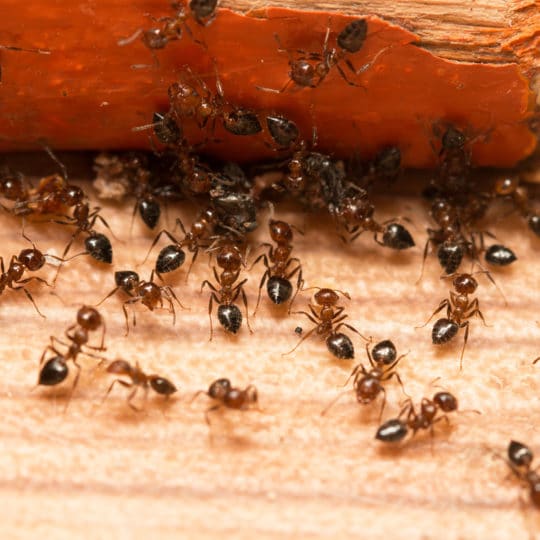Lawn Pest Library
Ants

Scientific Name: Formicidae
Lifespan: Up to seven years for a worker ant and as long as 15 years for a queen.
Brief description: Don’t look now, but ants are quietly surrounding you. These little insects outnumber humans on Earth by about one million to one. An estimated one to ten quadrillion ants live on our planet at any one time. Although tiny, ants contribute approximately one quarter of the total combined biomass weight of land-based animals. While ants can be fascinating and fun when contained to a child’s plastic ant farm, they can be annoying or downright dangerous when they invade a home.
What are Ants?
Ants are highly social insects that live in colonies ranging from a few dozen to millions of individuals. The colony is made up of three types of ants: the queen, the workers (which are all female), and males. Queen and male ants have wings, and worker ants, the most commonly seen variety of ant, are wingless. The ants often seen parading in a line are the female workers.
The ant life cycle has four distinct stages: egg, larvae, pupae and adult. The entire life cycle takes several weeks to several months to complete, depending on the species and other factors. Males live only a short time. Females live much longer, and queens can live for many years.
Ants are brown or black, depending on the species, and are distinguished, like a snowman, by its three segmented body parts. They range in size from 0.030 to two inches in length. Ants have an exceptionally tough exoskeleton that can withstand floods and attacks, and they can carry loads many times their own body weight.
Ants are some of the most common home invaders in the United States. They enter houses but also restaurants, warehouses and other buildings, seeking shelter, water, and food. Ants eat almost anything but are particularly crazy about sweets. Their presence can be undesirable, particularly in kitchens and areas meant to be sterile, unpleasant, when they bite or sting, or even downright destructive, when they invade food sources and damage indoor structures.
Signs and Symptoms of Ants
A few ants wandering around is no big deal, but if you see an army of large ants marching through the kitchen to get into your food cabinet, you might have a serious problem. Take immediate action if the paraders are large, reddish black ants. These are carpenter ants, and their aggressive chewing can cause significant damage to the wood in your home.
Ant nests can be difficult to track down. They can look like small piles of soil, or wood shavings, in the case of carpenter ants. Ants typically make them in dark, quiet corners or in walls. If you suspect a carpenter ants’ nest, put your ear on the wall to listen for faint rustling. Knock on wood that you think they might be living in. If they are nesting, the wood will sound hollow.
How to Prevent Ants
Locating and destroying an ant colony is the most direct and effective way to control an ant infestation. Your own defense strategy will depend on the type of infestation you have.
For ants that live outside your home but come inside looking for food or water, take steps to keep them out. Seal up cracks and crevices that ants can slip through, spray an insecticide near entry points, and keep floors clean, because ants rely on a trail of their own scent to find their way back to the colony. You can also try bait traps. Worker ants will carry the toxic baited material back to the nest, eliminating the colony. Baits need to be placed with care in areas where ants have been observed but where children and pets cannot reach them, because ant bait is poisonous.
For ants living inside the home, you will need to find their nest. If the residents are carpenter ants, you better find the nest quickly, or you could be dealing with major structural damage to your home. Try to follow the line of ants back to their nest. Ants like damp areas, such as spongy flooring or framing that was damaged from a roof leak. Check areas that might have water damage, such as attics, bathrooms and exterior walls. Cut a hole in damaged walls to find the nest (since you will need to repair that anyway). When you find the nest, spray it with an insecticide that contains bifenthrin, permethrin, or deltamethrin. Be sure to fix the water leak and replace damaged wood. If you can’t track down the nest yourself, hire a pest control service to find it. They know what to look for and can get the job done effectively and safely.
If unsightly anthills or parades of ants through your patio are a disturbance, spot treat the area with an outdoor insecticide. For bigger ant problems, use a lawn and garden insect killer that contains bifenthrin as the active ingredient. Keep in mind that this spray will kill other insects, too.
For lasting control, make your property less inviting to ants. Trim back bushes, shrubs, and trees that touch your siding or roof and that might provide a bridge for ants to get into the house. Check that the soil around the foundation of the house slopes down and away from the house. Avoid stacking firewood next to the house, where ants love to hide. And, as always, maintain a healthy lawn, since ants tend to colonize in bare spots and thatch.
Need Help with Ants?
Call today at and let's talk about how we can help you with Ants and other Lawn Pest Library.